Sigma 18-200mm f/3.5-6.3 DC
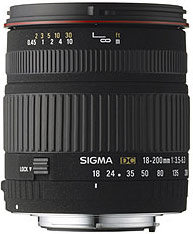 Specification
Specification
- Focal length 18-200mm
- Aperture f/3.5-6.3
- Angle of view 69.3 – 7.1º
- Filter size / type 62mm
- Construction Elements/groups 15 elements in 13 groups
- Focusing type Internal
- Closest focus 0.45m
- Weight 0.405kg
- Dimensions (Dia x length) 70x78.1mm
- Mounts available Sigma, Canon, Nikon, Pentax, Minolta
- Tripod bush No
- Price £329.99
Build and Handling
Supplied boxed and including lens and mount caps along with a petal shaped hood, this lens is finished in the matt black that is now common to all of Sigma’s lenses. Also in the box is a multi-language instruction leaflet and warranty paperwork for the statutory one year warranty.
The zoom ring, which occupies some 50% of the lens barrel in the closed (18mm) position, is nicely torqued and carries a zoom lock to hold the lens in the closed position when not in use. Once zooming commences, the lens extends by around 52mm by way of two tubes telescoping out to he 200mm position. Despite this, the front element does not rotate, making the use of filters that much simpler.
There is the normal AF/MF switch for those mounts that require it adjacent to the mount and in front of the zoom ring is the manual focus ring, which requires very little travel in use. Autofocus is not lightning and is accompanied by a slight whining noise but was quick enough and proved accurate in use. There is, however, no manual override when in AF mode so the motor needs to be dis-engaged to operate it. Once released, manual focus is light and easy to use and workable with one digit. Being designed for cropped sensors only, the lens is light in weight and, being compact as well, can easily be carried on the camera all day as a walkabout lens.
Optical Quality
As we have mentioned before, producing a lens of such a wide zoom range requires some compromises. As with other lenses in this group, Sigma have opted to get the better performance out of the lens at the shorter end and it decreases as the focal length increases. At the 18mm end, this lens produces quite decent results, good enough to print to A4 without problems. By the time it gets to the 200mm end, it does require stopping down a couple of stops to produce any sort of pleasing result. As the lens only gives you f/6.3 at this length, you are looking at good light conditions needed for f/11 and any decent shutter speed.
Chromatic aberrations, the bane of the digital photographer is again a little variable, being well controlled at the wide end but suffering a bit more as the focal length increases. Distortion, which is not such a big problem in the digital age, is also neutral at the wide end but becomes noticeably pin cushioned at the extreme long end. Contrast was fairly good for a lens in this class.
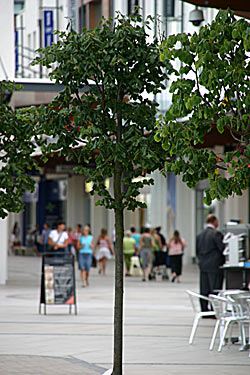 The idea was to isolate the tree with a blurred background. The f/6.3 wide aperture at the 200mm end did not achieve this too well. |
|
 Not designated as a macro lens, this was about as close as we could get to this dragonfly and still focus at the 200mm end. | 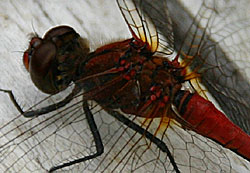 However, this 50% crop shows that good detail is achieved. |
Click on each comparision photo below to view full size versions
Below is our lens test data. To find out how to use these graphs look at this article: How we test lenses
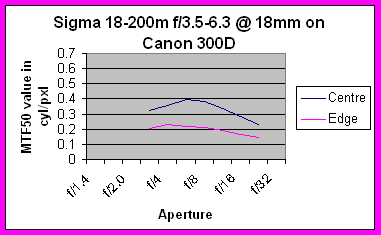
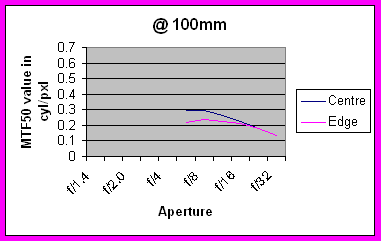
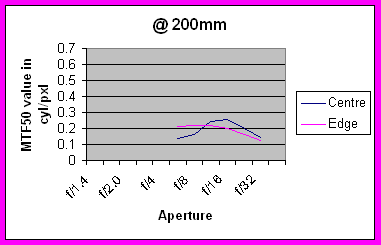
Verdict
This lens once again proves that it is extremely difficult to produce the ideal all-in-one lens. Whilst this one is very good at the wide end, it does start to show the limitations of the design type at the long end. But if you consider the advantages of just having the one lens and the reduction in lens changes that could let in dust, there are some saving graces. All in all it is a nice lens if you can put up with the long end fall off.
In summary the main positive points of the Sigma 18-200mm f/3.5-6.3 DC are:
![]() Performance at wide end
Performance at wide end
![]() Focal Range
Focal Range
![]() Size and weight
Size and weight
![]() Easy Manual Focus
Easy Manual Focus
Negative points are:
![]() Optical quality falls off towards telephoto end
Optical quality falls off towards telephoto end
![]() Autofocus a little noisy and slow.
Autofocus a little noisy and slow.
Check the latest price of the Sigma 18-200mm f/3.5-6.3 DC here
Test by Ian Andrews www.wildaboutkent.co.uk
Add your message
Please login here or if you've not registered, you can register here. Registering is safe, quick and free.
photodo Stats
428 MTF tests
74 in-depth photodo reviews
100+ users join each day
Help the lens community by reviewing or rating a lens today via our lens search
Latest Lens Reviews
- Chinon 28mm f/2.8 Vintage Lens Review
- Canon EF 70-200mm f/4L IS II USM Lens Review
- Samyang AF 85mm f/1.4 EF Review
- Sigma 70mm f/2.8 DG Macro Art Review
- Samyang AF 24mm f/2.8 FE Review
- Meike 50mm f/1.7 Review
- Tamron 70-210mm f/4 Di VC USD Review
- Lensbaby Burnside 35mm f/2.8 Review
- Asahi Super Takumar 50mm f/1.4 Review
- Asahi Super-Multi-Coated Takumar 135mm f/3.5 Review





